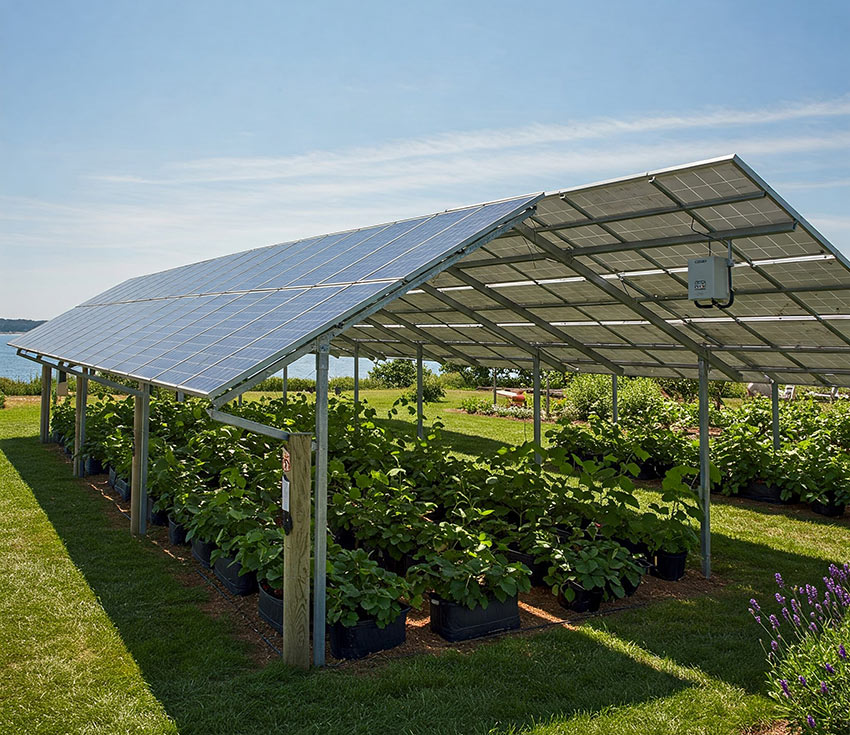In an era where sustainable solutions are increasingly vital, agrivoltaics stands out as an innovative approach that combines agriculture with solar energy production. This comprehensive guide explores the exciting world of agrivoltaics and its potential benefits for our community. We hope that by reading through this you will learn some innovative ways that small farms are taking advantage of combining photovoltaics and farming.
Understanding Agrivoltaics: The Basics
Agrivoltaics, also known as dual-use solar or solar sharing, refers to the practice of using land simultaneously for both solar photovoltaic power generation and agricultural activities. This approach maximizes land use efficiency by producing clean energy while maintaining food production capabilities.
The concept is elegantly simple: solar panels are installed above cropland or pasture at heights and configurations that allow sufficient sunlight to reach plants below while generating electricity from the sun’s energy. This symbiotic relationship creates numerous benefits for both energy production and farming operations. This is especially beneficial to plants that don’t like to be in sunlight at all times.
The History and Evolution of Agrivoltaics
The term “agrivoltaics” was first coined in 1981 by Adolf Goetzberger and Armin Zastrow, researchers who envisioned the potential of combining agriculture with photovoltaic technology. However, the practical implementation of these systems has gained significant momentum only in the past decade.
Early experiments in Japan by researcher Akira Nagashima demonstrated that certain crops could thrive under partially shaded conditions created by solar panels. Since then, research institutions worldwide have developed increasingly sophisticated agrivoltaic systems tailored to different crops, climates, and agricultural practices.
How Agrivoltaic Systems Work
Panel Configuration and Design
Agrivoltaic systems feature specialized designs that differ from traditional solar installations. Here’s how they’re typically configured:
1. **Elevated mounting structures**: Panels are installed higher off the ground (typically 8-12 feet) to allow farm equipment access and provide adequate light for plants.
2. **Strategic spacing**: Panels may be arranged with wider gaps between rows or in specialized patterns to optimize light distribution.
3. **Dynamic systems**: Some advanced installations feature tracking systems that adjust panel angles throughout the day to balance energy production with crop needs.
4. **Semi-transparent panels**: Certain applications utilize partially transparent photovoltaic modules that allow specific light wavelengths to pass through to plants below.
The Science Behind Successful Coexistence
The successful integration of solar panels and agriculture relies on understanding plant biology and solar engineering. Most plants don’t require 100% of available sunlight for optimal growth—many crops actually perform better with partial shade, especially in hot climates where excessive sun exposure can cause stress.
Solar panels create a microclimate that can benefit certain crops by:
1. Reducing water evaporation from soil
2. Providing protection from extreme weather events
3. Creating temperature moderation that can extend growing seasons
4. Offering shade during peak heat hours
Benefits of Agrivoltaics
Environmental Advantages
Agrivoltaics offers numerous environmental benefits that align with sustainable development goals:
1. **Reduced carbon footprint**: Generates clean energy while maintaining agricultural production.
2. **Water conservation**: Studies show up to 30% reduction in water requirements for some crops grown under panels due to reduced evaporation.
3. **Biodiversity support**: Proper implementation can create diverse habitats and microclimates that support pollinators and beneficial insects.
4. **Land use efficiency**: Maximizes productivity of available land, reducing pressure to develop natural areas.
5. **Climate resilience**: Helps crops adapt to changing climate conditions through microclimate management.
Economic Benefits for Farmers and Landowners
The dual-use approach provides compelling financial advantages:
1. **Diversified income streams**: Farmers can generate revenue from both crop production and energy sales or savings.
2. **Reduced irrigation costs**: Lower water requirements translate to cost savings.
3. **Extended growing seasons**: Modified microclimates can allow for longer productive periods.
4. **Crop yield protection**: Partial shading can protect certain crops during extreme heat events.
5. **Land value enhancement**: Properties with dual-purpose capabilities may increase in value.
Ideal Crops for Agrivoltaic Systems
Not all crops perform equally well in agrivoltaic settings. Based on research and implementation experience, certain plants have shown particular promise in these systems.
The following crops have demonstrated successful growth in agrivoltaic environments:
1. **Leafy greens**: Lettuce, spinach, kale, and other greens often thrive with partial shade.
2. **Berries**: Some berry varieties, including certain types of blueberries and strawberries, perform well.
3. **Root vegetables**: Potatoes, carrots, and other root crops can succeed in properly designed systems.
4. **Herbs**: Many culinary and medicinal herbs adapt well to the modified light conditions.
5. **Certain fruit trees**: When panels are sufficiently elevated, some dwarf fruit tree varieties can be incorporated.
6. **Pasture grasses**: Livestock grazing can be compatible with elevated solar installations.
Agrivoltaics on Martha’s Vineyard: Potential and Considerations
Martha’s Vineyard’s unique geography, climate, and agricultural heritage make it an intriguing candidate for agrivoltaic implementation. The island’s commitment to sustainability aligns perfectly with this innovative approach.
Local Suitability Factors
Several factors make the Vineyard potentially suitable for agrivoltaics:
1. **Limited land availability**: The island’s finite land resources create incentives for dual-use approaches.
2. **Strong solar resource**: Martha’s Vineyard receives ample sunlight for effective photovoltaic generation.
3. **Agricultural heritage**: The island’s farming traditions and local food movement provide a foundation for innovative agricultural practices.
4. **Climate challenges**: Increasingly variable weather patterns affecting local agriculture could be partially mitigated by agrivoltaic systems.
5. **Energy resilience needs**: As an island community, energy independence and resilience are particularly valuable.
Regulatory and Implementation Considerations
Before pursuing an agrivoltaic project on Martha’s Vineyard, several important considerations must be addressed:
1. **Zoning regulations**: Local zoning laws may need to be reviewed or updated to accommodate dual-use installations.
2. **Conservation restrictions**: Many island properties have conservation restrictions that would need to be evaluated.
3. **Visual impact**: Thoughtful design that respects the island’s aesthetic character is essential.
4. **Scale appropriateness**: Systems should be sized appropriately for the local context and needs.
5. **Community engagement**: Early and transparent communication with neighbors and community members is crucial.
Getting Started with Solar: Residential Options
While full agrivoltaic systems are typically implemented at farm scale, residential property owners on Martha’s Vineyard can still participate in the solar revolution. Farley Built, Inc. specializes in designing and installing high-quality residential solar panel systems tailored to the unique needs and characteristics of island homes.
Key Considerations for Residential Solar on Martha’s Vineyard
When considering solar for your home, keep these factors in mind:
1. **Roof orientation and shading**: South-facing roofs with minimal shading provide optimal conditions.
2. **Historical district regulations**: Properties in historic districts may have specific requirements.
3. **System sizing**: Professional assessment helps determine the appropriate system size based on energy needs.
4. **Battery storage options**: Island power reliability can be enhanced with battery backup systems.
5. **Incentives and financing**: Various financial incentives can significantly reduce installation costs.

Conclusion: The Future of Sustainable Energy and Agriculture
Agrivoltaics represents a promising frontier in our collective effort to address energy needs, food security, and environmental sustainability simultaneously. As climate challenges intensify and land use pressures grow, innovative approaches that maximize productivity while minimizing environmental impact will become increasingly valuable.
At Farley Built, Inc., we’re committed to bringing sustainable energy solutions to Martha’s Vineyard residents. Beyond solar, we specialize in energy-efficient home construction that complements renewable energy systems, creating truly sustainable living environments. Contact us today to learn how we can help you participate in the clean energy transition while preserving the natural beauty and character of Martha’s Vineyard.
